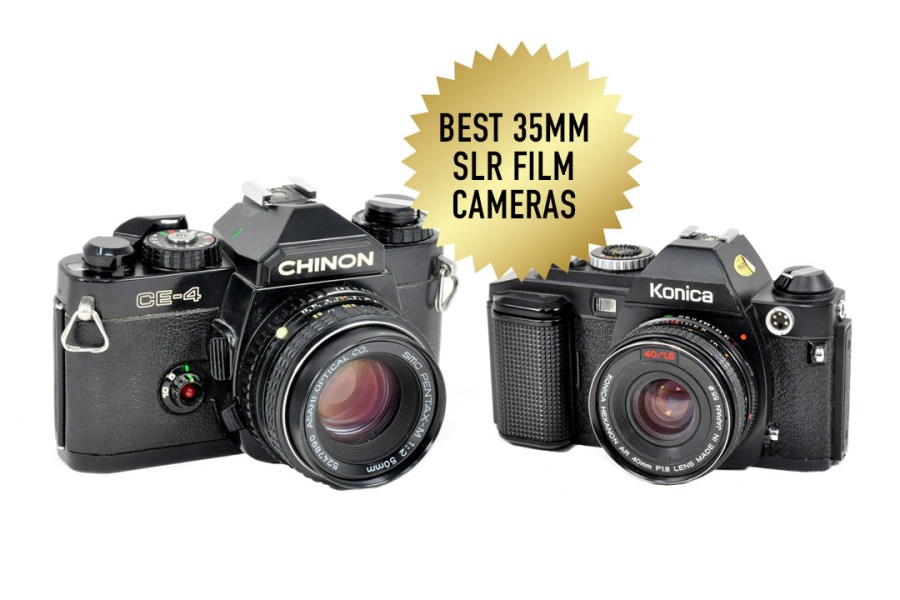In the pre-autofocus era of the late 1970s and early 1980s manual focus single lens reflexes (SLRs) reached their peak. It was a time when electronic shutter wizardry, sophisticated metering and attractive yet functional design came together with top-quality lenses to produce a series of world-beating cameras. Once you get used to twisting a focusing ring while watching a rangefinder, many of these can still make worthwhile investments today.
Let’s begin by taking a look at what was considered the best 35mm SLR film cameras back then from the ‘Big Five’ – Canon, Minolta, Olympus, Nikon and Pentax – and to select two cameras from each maker, one aimed at the consumer end of the market, the other aimed at professionals.
Best 35mm SLR film cameras with manual focus – Canon
Best 35mm SLR for consumers – Canon T90 (1986)
Used Price | £40-70 / $65-70 approx.
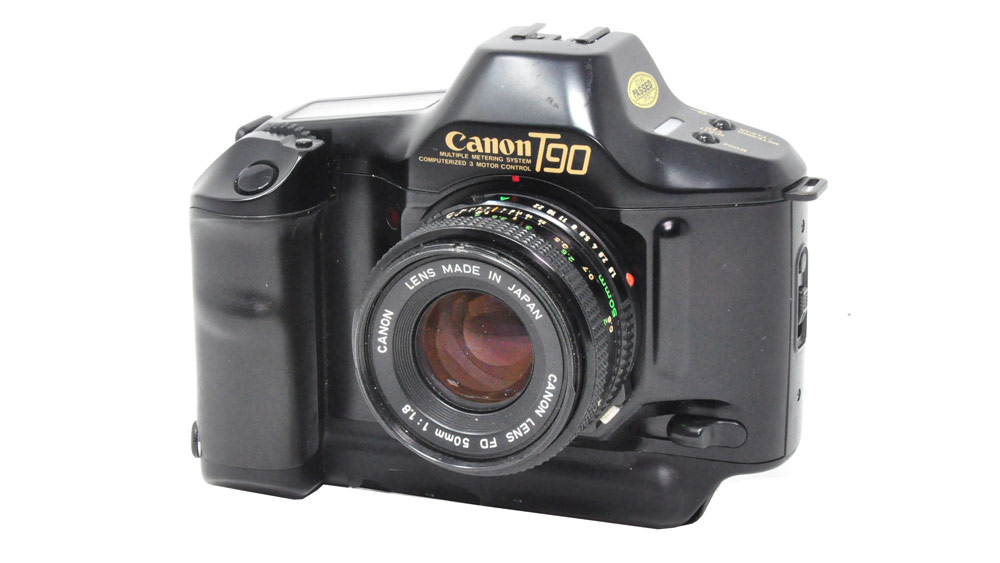
Canon T90: the last and the best of the T-series of cameras. Photo credit: John Wade
The first cameras in Canon’s T-series were strangely designed, plasticky and, these days, forgettable. The last in the series, Canon’s final manual focus SLR, is something else. Its modernistic design boasts smooth curves around the pentaprism hump, continuing in a comfortable hand grip topped by the shutter release.
Inside, the Multiple Metering System offers centre-weighted average metering, 13% partial area metering, 2.7% spot metering, multi-spot metering, highlight and shadow spot metering. Exposure control includes a selectable safety shift function to shutter and aperture priority, plus standard program, variable shift program with seven options, stopped down auto exposure and fully manual.
And it takes the full range of Canon’s prestigious FD mount lenses.
Best 35mm SLR for professional photographers – Canon New F-1 (1981)
Used Price | £250-300 / $280-400 approx.
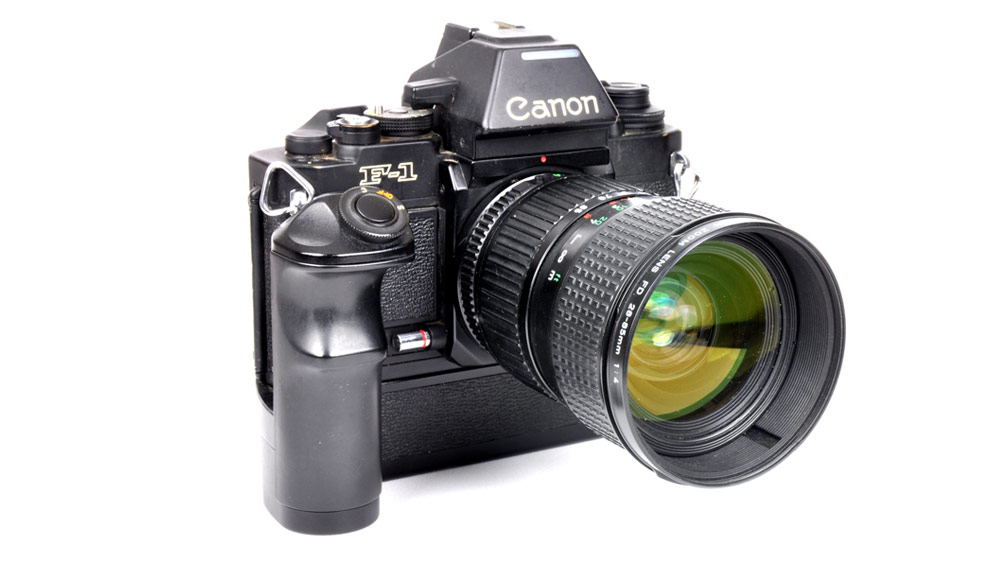
Canon New F-1, fitted with its AE finder, AE Power Winder and 28-85mm f/4 Canon lens. Photo credit: John Wade
If you’re looking for rugged reliability coupled with simple versatility, consider this third version of the Canon F-1. Shutter speeds of 1/60 second and below are electronically controlled; 1/125 second, all the way to 1/2,000sec are mechanical.
The basic camera features match-needle, through-the-lens metering with speed and aperture indicators shown in the viewfinder. Replace the standard viewfinder with the AE version, set the speed dial to ‘A’ and the camera is converted to aperture priority. Add the AE power winder or motor drive to the base, set the lens to its ‘A’ setting and the camera is set up for shutter priority as well.
The F-1 is part of a system that includes more interchangeable viewfinders and focusing screens, databack, bulk film back – and, of course all the Canon FD lenses.
Best 35mm SLR film cameras with manual focus – Minolta
Best 35mm SLR for consumers – Minolta XD7 (1978)
Used Price | £50-100 / $100-200 approx.

Minolta XD7; the first multi-mode 35mm SLR. Image © John Wade
This was the first electronic multi-mode exposure SLR. Set the mode selector switch to ‘M’ for total manual control. Set the switch to ‘A’, choose an aperture and the camera sets the correct shutter speed, irrespective of the setting on the speed dial. Set the switch to ‘S’ and the lens to its smallest aperture, select a shutter speed and the camera sets the correct aperture.
If your chosen speed means over- or under-exposure because the lens has run out of apertures for a correct reading, the automation overrides your setting and sets a faster or slower speed. The shutter is electronic, but the ‘0’ setting on the speed dial gives a mechanical 1/100sec, so the XD7 can still be used if the battery fails.
Best 35mm SLR for professional photographers – Minolta X-1 (1973)
Used Price | £275-350 / $280-370 approx.

Minolta XK, also known as the X-1 and XM. Photo credit: John Wade
The X-1 (also known as the XK in America and the XM in Europe) is big and bold. It was Minolta’s first interchangeable lens SLR with an electronic focal plane shutter using titanium curtains.
The camera offers manual and aperture priority exposure, which uses contrast light compensation average metering to deal with contrasty light conditions. It also accepts six interchangeable viewfinders. They include the AE-Finder for aperture priority, M-Finder for manual match-needle metering, P-Finder for a plain view with no metering, H-Finder which is unmetered but with 6.2X magnification, W-Finder for use at waist level and the AE-S Finder. This last one substitutes a silicon cell for the usual CdS metering cell, necessary to provide automatic metering at up to 3.5 frames per second continuous shooting when using the dedicated motor drive.
Both cameras take Minolta’s MC-mount lenses.
Best 35mm SLR film cameras with manual focus – Nikon
Best 35mm SLR for consumers – Nikon EM (1979)
Used Price | £40-75 / $60 approx.

Nikon EM, the first SLR from the company to be aimed at amateurs. Photo credit: John Wade
This was the first truly amateur-inspired camera to bear the Nikon name. It’s a compact-size aperture priority camera with automatically selected shutter speeds that run steplessly from 1–1/1,000sec. In place of a speed dial the camera offers a mode selection switch that can be set to ‘auto’ , ‘B’ and ‘M90’, the last giving a mechanical 1/90sec, for use mainly with non-dedicated flashguns. Pressing a tiny white button beside the lens gives an instant +1.5 stops exposure compensation. The EM accepts many, though not all, of the older Nikkor AI and non-AI lenses, but was launched with its own range of smaller, lighter and less expensive Nikon Series E lenses.
Best 35mm SLR for professionals – Nikon F3 (1980)
Used Price | £300-350 / $260-400 approx.
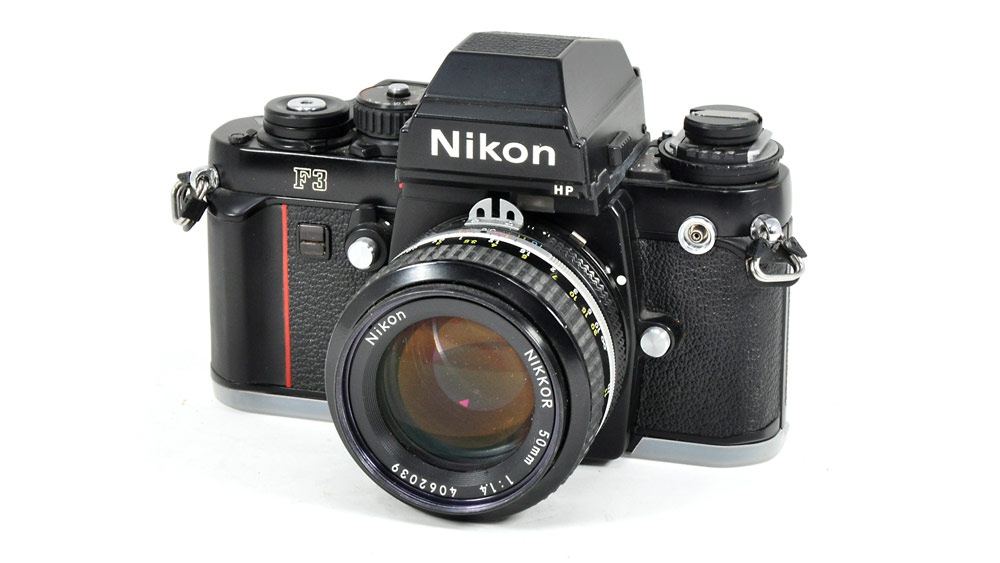
Nikon F3: the company’s last manual focus SLR. Photo credit: John Wade
Nikon’s last manual focus SLR follows in the illustrious footsteps of the original Nikon F, though with a sleeker design and a meter in the body rather than the prism, meaning it works with all the camera’s interchangeable viewfinders.
Aperture priority exposure, through-the-lens flash capability, interchangeable focusing screens, mirror lock-up and a quartz-timed shutter are all on board. Electronic shutter speeds run to 1/2,000sec, but a 1/60sec manual speed can be triggered without a battery from a control on the front of the body.
Although the F3 accepts all F-mount lenses, it will only meter at full aperture when using AI and AIS lenses. With older non-AI lenses, metering functions in stopped-down mode.
Celebrating 40 years of the Nikon F3
Best 35mm SLR film cameras with manual focus – Olympus
Best 35mm SLR for consumers – Olympus OM10 (1979)
Used Price | £50-75 / $40-80 approx.

Olympus OM10 with its manual adapter fitted. Photo credit: John Wade
In 1972 Olympus revolutionised the 35mm SLR world with the introduction of the compact-size OM-1, which led to the OM-2, OM-3 and OM-4. While that range was being developed, a second range came to the market, lacking some of the features of their counterparts and aimed much more at the general consumer. The OM10 was the first.
It’s an aperture priority camera, without a shutter speed control and no manual override, other than plus or minus two stops compensation. However, for those who need a little more control, a manual adapter is available which slots into a socket on the front of the body and adds manual control with 1-1/1,000sec shutter speeds.
Despite the simplicity of the camera’s operation, it accepts the full range of Olympus OM lenses.
Best 35mm SLR for professional photographers –
Olympus OM-4 (1983)
Used Price | £150-250 / $120-300 approx.

Olympus OM-4 from the professional end of the OM range. Photo credit: John Wade
The most advanced camera in the Olympus OM stable is an aperture priority model with manual override and multi-spot metering. This works by measuring and storing up to eight spot measurements, then calculating the optimum setting for correct exposure. If a subject is predominantly light or dark, the photographer can apply manual compensation.
Exposure and shutter speed information are conveyed by an LCD in the viewfinder. The OM-4Ti, released in 1987, is basically the same camera with the addition of titanium body panels and a few internal tweaks. Both cameras take the full range of Olympus OM lenses.
Best 35mm SLR film cameras with manual focus – Pentax
Best 35mm SLR for consumers – Pentax ME Super (1980)
Used Price | £40-80 / $40-80 approx.
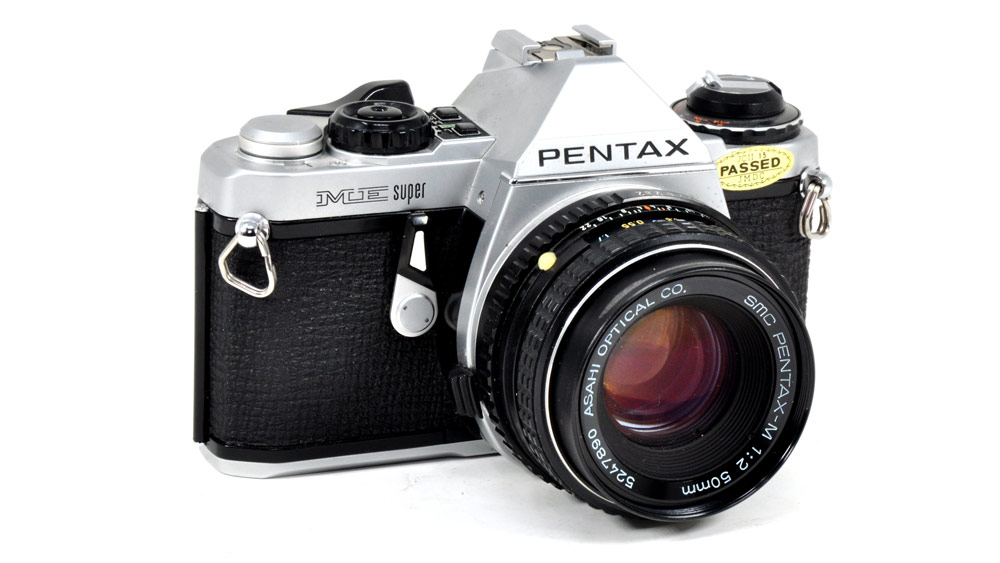
Pentax ME Super which used electronic push-button controls. Photo credit: John Wade
The original Pentax ME, made in 1976, was a typical compact 35mm SLR of the period. What makes the revamped ME Super special is its early use of electronic controls in place of traditional knobs and dials. In manual use, two small black buttons set into the top plate are used to increase or decrease the shutter speeds, which are indicated on a scale in a viewfinder that seems huge for the size of camera. A 1/125sec mechanical speed is available, while switching the camera to auto gives aperture priority.
The ME Super accepts Pentax K-Mount lenses.
Best 35mm SLR for professional photographers -Pentax LX (1980)
Used Price | £300-400 / $300-400 approx.
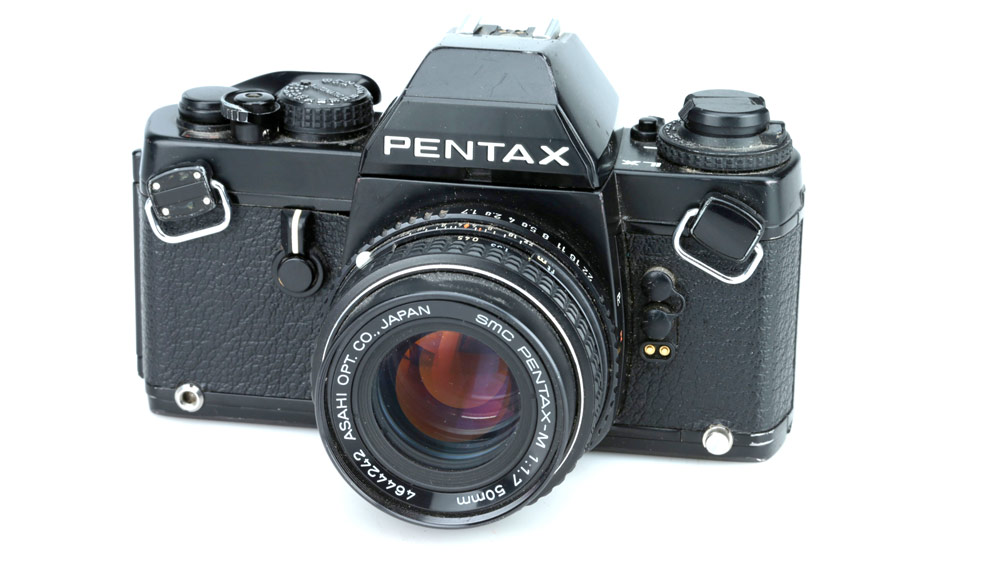
Pentax LX: the company’s only attempt to produce a professional 35mm SLR. Image courtesy of Flints Auctions
The LX was Pentax’s only attempt to enter the 35mm professional SLR market, but they did it with a beauty. The camera stands at the centre of a system that includes interchangeable viewfinders, backs, winders, even a choice of detachable hand grips.
Manual and aperture priority modes are available with electronic shutter speeds of 1/60sec and below, while 1/75-1/2,000sec are mechanical.
The Integrated Direct Metering exposure system measures light at the film plane, right at the moment of exposure as the mirror flips up. It does this via a silicon photo diode which, in 1980, was considered the most accurate metering system around.
All of this is tied up in a package that is smaller and lighter than other professional models from Canon, Minolta and Nikon.
Other good manual focus 35mm SLRs to consider
Remembering manual focus SLRs of the 1970s and 1980s? It’s easy to forget that the Big Five were not the only contenders. Quietly simmering in their shadows were other quality cameras from names like Chinon, Cosina, Fujica, Konica, Mamiya, Petri, Praktica, Ricoh, Yashica, Zenith and more.
Here are six other best 35mm SLR film cameras with manual focus to consider:
Yashica FR1 (1977)
Used Price | £50-75 / $90-130 approx.

Yashica FR1, a stripped down version of the Contax RTS. Photo credit: John Wade
The first Yashica SLRs from 1960 used a unique lens mount, but in 1961 the company switched to the M42 screw mount used by Pentax and others. Then, in 1976, Yashica joined forces with Contax to produce a series of SLRs with a shared mount that accepted both Yashica and Zeiss T* lenses. The FR1 is one such, an electronically-controlled SLR based on the extremely prestigious, Contax RTS.
Konica FS-1 (1979)
Used Price | £30-50 / $30-60 approx.
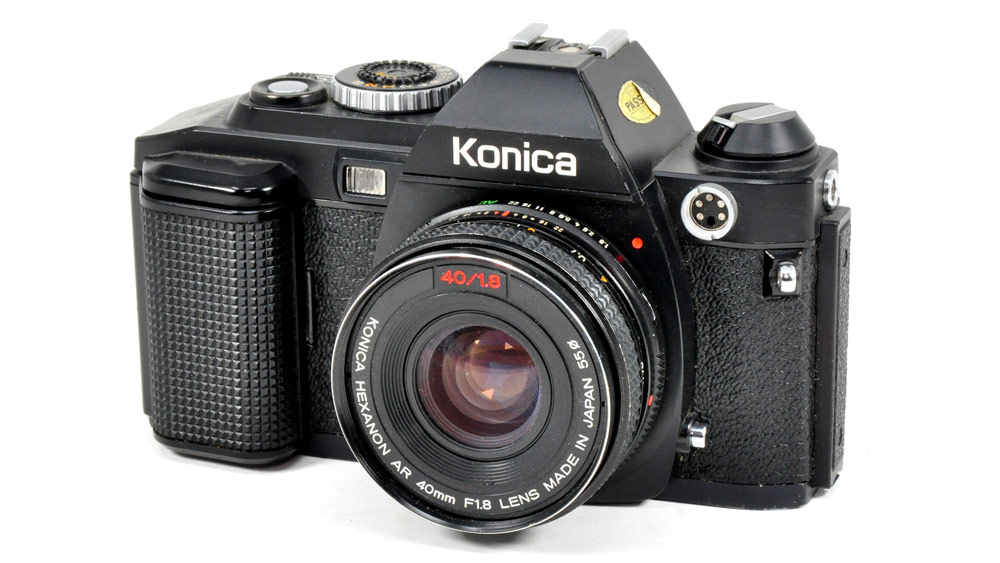
Konica FS-1: the first Japanese SLR with electric power wind. Photo credit: John Wade
Konica produced its Auroreflex series of top-class SLRs, starting in the mid-1960s. Then, in 1979, the company introduced the FS-1, its first electronic SLR. Providing you ignore a virtually unknown soviet fixed lens camera made in the 1960s, the FS-1 was the first SLR with a built-in battery-driven power wind. It runs on four AA batteries located in the hand grip to give one frame per second.
The camera accepts only lenses in Konica’s own bayonet mount.
Fujica ST605N (1976)
Used Price | £20-40 / $20-40 approx.
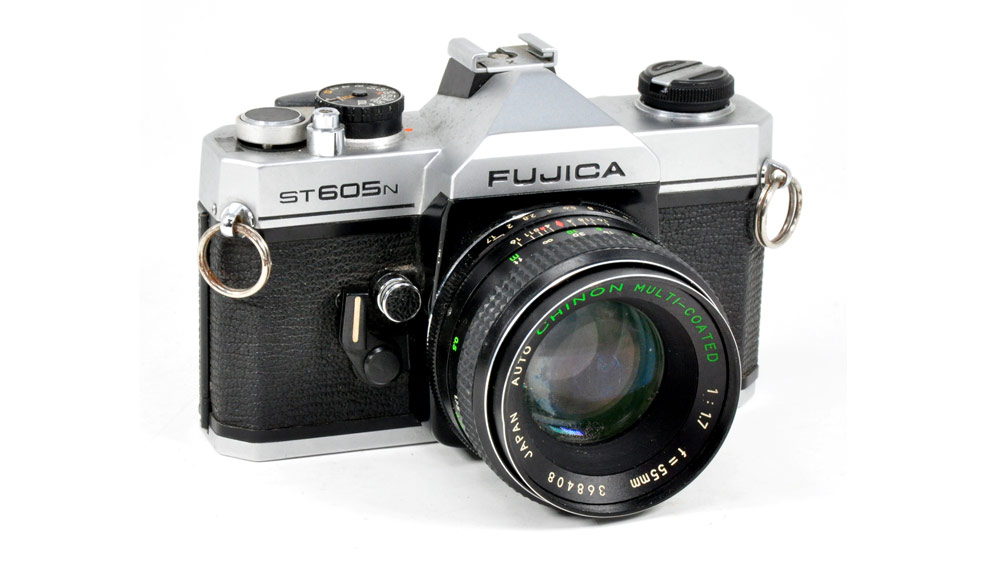
Fujica ST605N which enjoyed the versatility of an M42 lens mount. Photo credit: John Wade
This is a solidly built, attractively styled SLR with an M42 lens mount which means, alongside its own range of Fujinon lenses, it takes a vast range of screw-mount lenses. Only match-needle stop-down metering is available and the shutter speed range is restricted to 1/2-/700sec. But despite that, early Fuji cameras like the ST605N remain more versatile than later models which, from 1979, switched to Fuji’s own propriety bayonet mount, immediately restricting compatibility with the great many M42 lenses available then and now.
Ricoh KR-10 (1980)
Used Price | £20-30 / $15-50 approx.

Ricoh KR-10 which shared its K-mount with Pentax lenses. © John Nuttall via Wikimedia Commons)
Ricoh began making SLRs in the mid-1960s, and at first adopted the M42 screw lens mount. But when Pentax switched to the bayonet K-mount in the mid-1970s, Ricoh switched with them, thus maintaining the versatility that goes with the use of ubiquitous K-mount lenses.
The KR-10 is a fairly basic SLR with manual plus aperture priority exposure and an electronic shutter that goes down to a full eight seconds in aperture priority mode. A mechanical speed of 1/90sec is available if batteries fail.
Chinon CE-4 (1979)
Used Price | £15-25 / $15-30 approx.
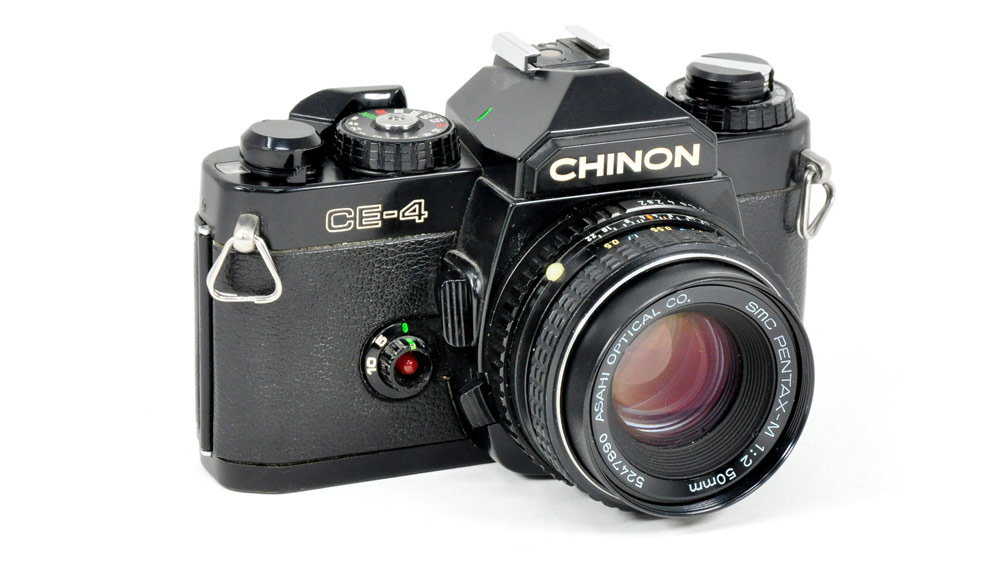
Chinon CE-4, another K-mount SLR, fitted here with a Pentax-M lens. Photo credit: John Wade
Chinon was another of those manufacturers that rode aboard the M42 lens mount while it was popular, then hopped over to the K-mount once that had attained the necessary popularity.
The CE-4 was the first Chinon camera to make that change. It offers manual and aperture priority metering. Although Chinon (along with Cosina) had a reputation for being at the cheap end of the SLR market, the company’s cameras were good, basic models. The CE-4 accepts a power winder with an optional remote control.
Praktica BX20 (1987)
Used Price | £25-40 / $20-50 approx.

Praktica BX20: more of a bargain today than when it was launched. Photo credit: John Wade
Prakticas had always been known as good solid workhorses, metal-made, mechanically sound, manually operated and with M42 mounts. But while Japanese manufacturers gradually built towards peaks of perfection in the manual focus SLR market, the Pentacon works in what was then East Germany battled to pull Praktica into the electronics age. They achieved that in 1979 with the B200, the company’s first camera to use an electronic shutter and first with the Praktica bayonet mount.
Over the following years, the range of Praktica cameras gradually morphed into the final BX series, of which the BX20 was the first. Functions include aperture priority, through-the-lens metering and flash measurement, a stepless electronic shutter speeded 1-1/1,000sec and LED viewfinder indicators.
When the Praktica’s first electronic cameras were launched, they were priced higher than their Japanese equivalents. Today the reverse is true.
Best 35mm SLR film cameras – the forgotten classics
Manual focus 35mm SLRs might have reached their peak in the 1980s, but they had been around since 1936 when Ihagee produced the Kine Exakta, the first 35mm SLR.
Here are three classic manual focus 35mm SLR cameras that are still very usable despite being largely forgotten today.
Praktina IIa (1958)
Used Price | £60-90 / $60-120 approx.
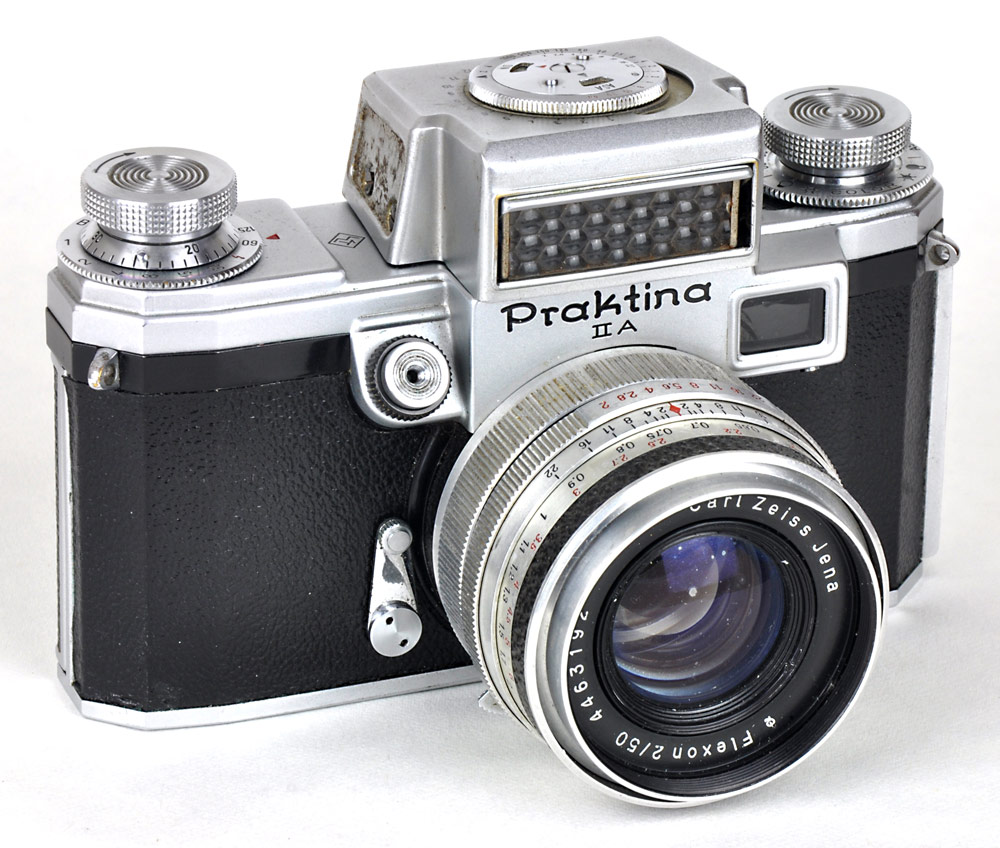
Praktina IIa with its metered pentaprism viewfinder fitted. Photo credit: John Wade
By today’s standards, this is a well-made but unremarkable German SLR, manually operated with a 1-1/1,000sec focal plane shutter, knob film wind and unusual for having an extra direct vision viewfinder beside the reflex finder. It is, however, the lenses and accessories that make it special. Lenses from 24mm to 1,000mm were made by the likes of Carl Zeiss, Meyer-Optik, Angenieux, Isco, Kilfitt, Schneider and Steinheil, all of which fit to the body via a breach lock mount.
Accessories include four interchangeable viewfinders, replaceable focusing screens, clockwork and electric motor drives, a lever wind that fits to the base to replace the top-mounted wind knob and a huge film back for 17 metres of film to shoot 450 exposures.
For close-up photography, there are manual and automatically coupled extension rings and a range of extension bellows. And all this a year before the launch of the Nikon F, more usually thought of as the first 35mm system SLR.
Zeiss Ikon Contarex (1960)
Used Price | £150-250 / $180-300 approx.
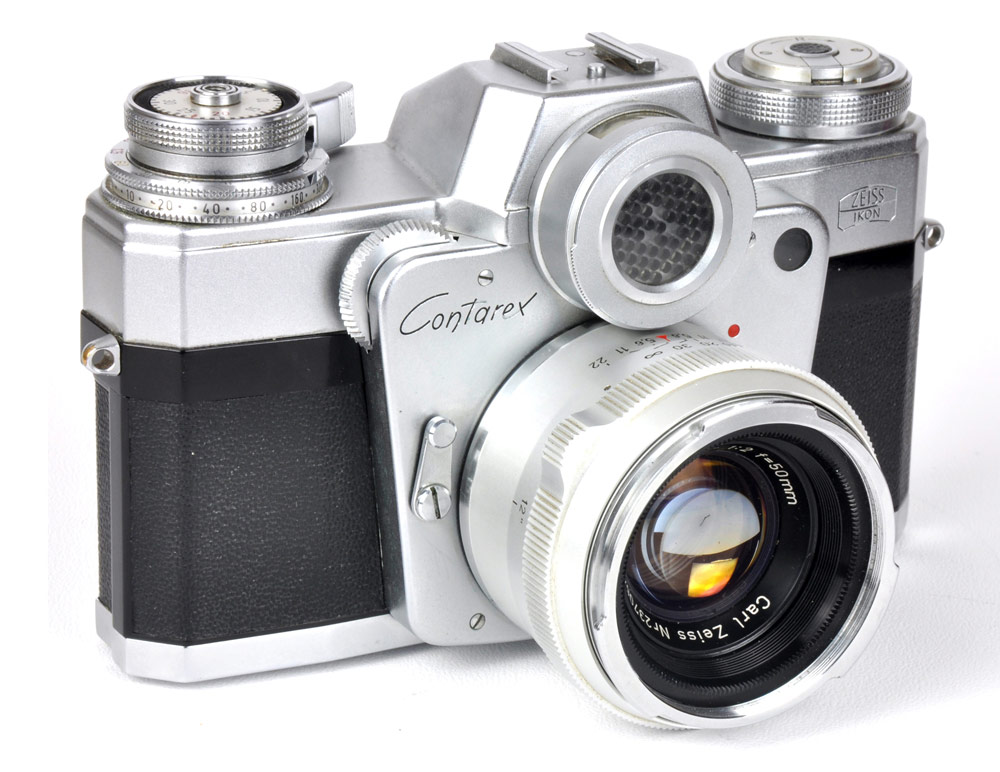
Zeiss Ikon Contarex, also known as the Bullseye and Cyclops. Photo credit: John Wade
Nicknamed the Bullseye or Cyclops because of its large, round selenium cell meter above the lens, this is a big, heavy, brute of a camera – but what quality! An aperture scale is inset into a curved window above the meter, with f-stops controlled by a thumb wheel beside the lens.
Shutter speeds of 1-1/1,000sec are set on a ring around the film advance lever. As each is adjusted, match-needle metering shows the correct exposure with indicators in the viewfinder and in a top plate window.
A split image rangefinder aids focusing and bayonet-mount interchangeable lenses carry prestigious names like Planar, Distagon, Sonnar and Tessar.
Topcon RE Super (1963)
Used Price | £100 / $100-200 approx.
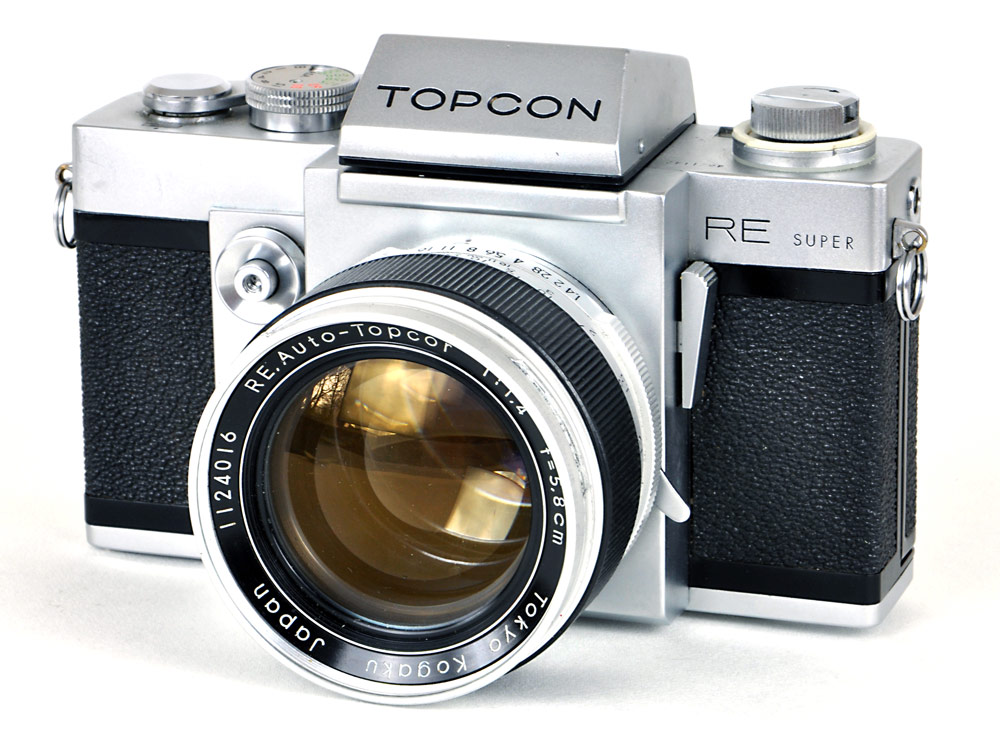
Topcon Re Super, the first SLR with through-the-lens metering. Photo credit: John Wade
Time was when Topcon was a name up there with the best of 35mm cameras, and the company’s RE Super was the world’s first SLR with through-the-lens metering. The system works by a specially adapted reflex mirror with a pattern of transparent lines etched into it, allowing some light to pass through the mirror to a CdS meter cell at the rear.
As apertures and shutter speeds are adjusted, match-needle metering indicates correct exposure in the viewfinder and in a top plate window. Accessories include eye-level and waist-level viewfinders, interchangeable focusing screens, extension tubes, bellows, slide copying and microscope attachments, electric motor drive and a wide range of bayonet-fit lenses in Exakta-style mounts.
Written by John Wade.
Looking for more film photography tips? Here are some more articles:
130 years of cameras – timeline
How to do film photography on a budget
Classic film cameras

